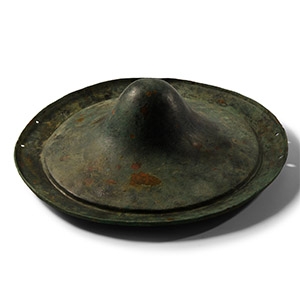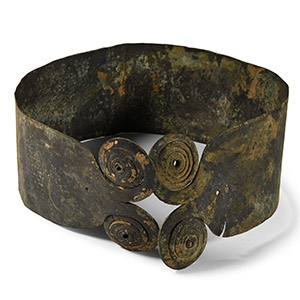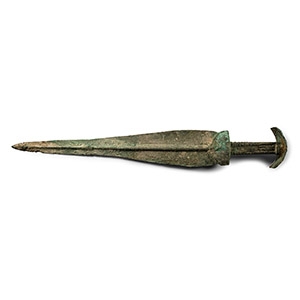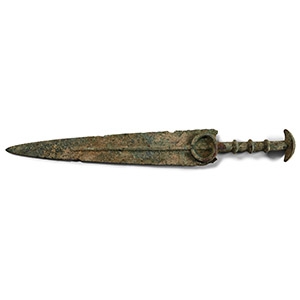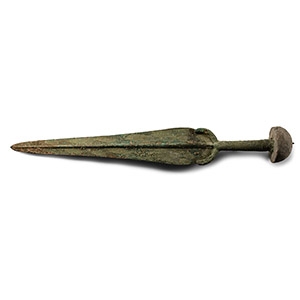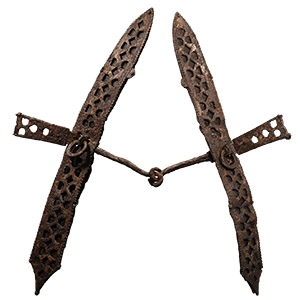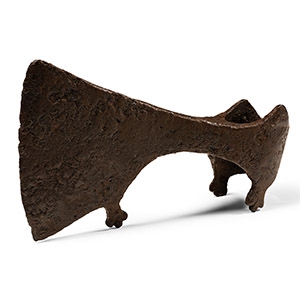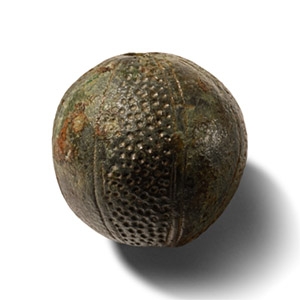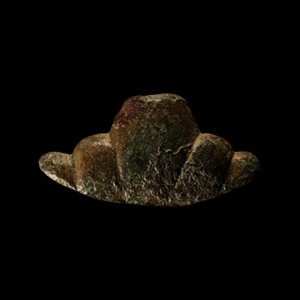Home > Auctions > 3 - 8 September 2024
Ancient Art, Antiquities, Natural History & Coins
Auction Highlights:
UK private collection before 2000.
Acquired on the UK art market.
Property of a London gentleman.
Cf. Overlaet, B., ‘The chronology of the Iron Age in the Pusht-I Kuh, Luristan’ in Iranica Antiqua, vol.XL, 2005, pl.13, no.14, for a recent find of a similar shield; see also Ayazi, S., Disc-Headed Bronze Pins from Luristan: A Symbol of Ancient Iran’s Past, Tübingen, 2008.
These kind of shields, of small dimensions, were used by infantry or horse-archers of Luristan and neighbouring cultures (Elamites, Zagros Tribesmen, like Hurrians, Lullubians, Kutians, and Kassites, Assyrians), as well as by Urartu, West-Iranian and Northern Caucasian civilisations around the Caspian Sea. The bronze boss was probably attached to a leather and wooden background.
UK private collection before 2000.
Acquired on the UK art market.
Property of a London gentleman.
Cf. Gorelik, M., Weapons of Ancient East, IV millennium BC-IV century BC, Saint Petersburg, 2003, in Russian, for similar belts from Luristan with decorated surfaces (plate LIX, nos.19-20).
The rich and noble aristocrats of Luristan, Elamites, Hurrians, Lullubians, Kutians, and Kassites, went to battle splendidly equipped and used magnificent bronze armours. For metal sheets used for quiver plaques and bronze protective belts or shields, they used the hammering technique (Čakoškāri).
Ex London, UK, collection, 1990s.
See Maxwell-Hyslop, R., 'Daggers and swords in Western Asia: a Study from Prehistoric Times to 600BC,' in Iraq, Volume 8, 1946, pp.1-65, pl.IV, figs.32-32a.
Acquired 1980-2015.
Ex Abelita family collection.
Cf. Khorasani, M.M., Arms and Armour from Iran. The Bronze Age to the End of the Qajar Period, Tübingen, 2006, items 42 and 43.
These kind of bronze daggers or dirks, typical of Marlik culture, were cast in a one piece mould according to Negahban, although in some specimens the penannular guard was later cast into the blade. The separate sets of encircling ribs on the grips are again typical of swords from the Marlik area.
Ex London, UK, collection, 1990s.
See a similar sword in Christie's, The Axel Guttmann Collection of Ancient Arms and Armour, part 1, London, 2002, item 24, p.27.
This category of swords has been classified by Khorasani as 'swords with a mushroom pommel' and are usually characterised by a solid-cast hilt with a penannular guard, a ribbed or variously decorated grip and the conical hollow-cast mushroom pommel. Usually the blade is multi-fullered and tapers to a sharp tip. Moorey considers them to be from the end of the 2nd millennium B.C.
Acquired 1980-2015.
Ex Abelita family collection.
Cf. Khorasani, M.M., Arms and Armour from Iran. The Bronze Age to the End of the Qajar Period, Tübingen, 2006, items 42 and 43, for similar.
These kind of bronze daggers or dirks, typical of Marlik culture, were cast in a one piece mould according to Negahban, although in some specimens the penannular guard was later cast into the blade. The separate sets of encircling ribs on the grips are again typical of swords from the Marlik area.
Acquired 1980-2015.
Ex Abelita family collection.
See a similar sword in Muscarella, O.W., Bronze and Iron Ancient Near Eastern Artifacts in the Metropolitan Museum of Art, New York, 1988, pp.167-168, no.166.
In this sword it is possible that hilt and blade were not cast as one unit, but rather that the hilt was cast onto the blade. The thick guard is related to the crescent type, but here is almost rectangular, albeit with rounded shoulders, like in the blade of Metropolitan published by Muscarella.
From the private collection of a London gentleman, from his grandfather's collection formed before the early 1970s.
Cf. Shcerbakov, I. Dzys, Ledovoe Battle, 1242 A.D. (The Battle of the Peipus Lake), Moscow, 2001 (in Russian), fig.12, for a similar bit.
The snaffle bits consisted of two parts: a bit, which was placed in the horse's mouth, and cheekpieces, which were connected to the reins and head strap.
From the private collection of a London gentleman, from his grandfather's collection formed before the early 1970s.
Cf. similar specimen in the Swedish Historical Museum, inventory no.120502_HST, found in a field at Rommunds, Gammelgarn Parish, Gotland; cf. also Hjardar, K. & Vike, V., Vikings at war, Oxford-Philadelphia, 2016, p.161, for a similar example in the typology of decorated axes.
The axe head was made in a particular shape showing elements of plant ornamentation and it may have been used both as a battle axe and working axe. Most men were farmers or labourers on a farm and rarely carried a weapon other than a knife and an axe. Nevertheless, battle, the hunt and the ability to ride were important elements of what constituted the ideal Viking man.
Found Suffolk, UK.
From the private collection of a London gentleman, from his grandfather's collection formed before the early 1970s.
Accompanied by an academic report by Dr Raffaele D'Amato.
This lot has been checked against the Interpol Database of stolen works of art and is accompanied by search certificate number no.12177-221435.
See Oakeshott, E., The sword in the Age of the Chivalry, Woodbridge, 1964 (1997); Dufty, A.R., European swords and daggers at the Tower of London, London, 1974; Oakeshott, E., Records of the Medieval Sword, Woodbridge, 1991.
The sword belongs to the type of ‘war swords’, although it is challenging to establish if it belongs to the type XI or type XII of Oakeshott's classification. It corresponds well with an English sword of type XI kept in the Tower Armoury (Dufty, 1974, plate 2, letter a), found in a peat bog near Newbury; but it also presents many characteristics of swords of type XII: it presents similarity to two swords excavated by Dr Jorma Leppaaho in 1950, from late Viking graves, one having a cross guard identical to our specimen and the other an identical pommel (Oakeshott, 1991, p.69, lett. V and VI); and another similar specimen is (a water find from Denmark) preserved in the Nationalmuseet of Copenhagen. In general the taper of the blade points more to the nature of the XII typology.
Found Market Rasen, Lincolnshire Wolds, UK, 1970s.
Property of Mr A.B., an American collector.
See Peirce, I., Swords of the Viking Age, Woodbridge, 2002, p.104-5.
157 - 168 of 3369 LOTS

.jpg)

.jpg)
.jpg)
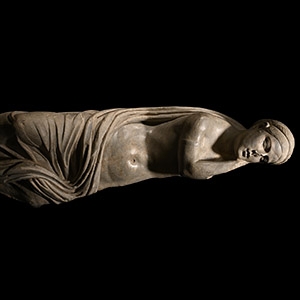
.jpg)
.jpg)

